As an Amazon Associate I earn from qualifying purchases. This website also participates in other affiliate programs and may earn commissions if you shop through the links used on this website.
(This article was originally published on September 7, 2021 and was last updated on September 15, 2022)
Looking for an easy way to grow more basil for your kitchen, really quickly? It’s super simple to grow basil from cuttings! If you’re wondering how to propagate basil from cuttings, and get more basil, faster, without constant trips to the grocery store, keep reading for these step-by-step instructions.
How to Propagate Basil from Cuttings
To grow basil from cuttings, start with a healthy basil plant. Prune the mother plant, cutting the stem just above the lowest node of leaves to create a fresh cutting. Remove the lowest set of leaves from the cutting (leave the top leaves in place), and trim the stem about 1/4″ below the lowest node. Fill a glass of water with fresh, un-chlorinated water. Place the cutting in the water, keeping the top leaves above the waterline, resting on the rim of the cup. Set the cup and cutting somewhere sunny, changing the water every couple of days. Over 3 to 4 weeks, the cutting should develop a robust root system. At this point, you can transplant it into potting soil.
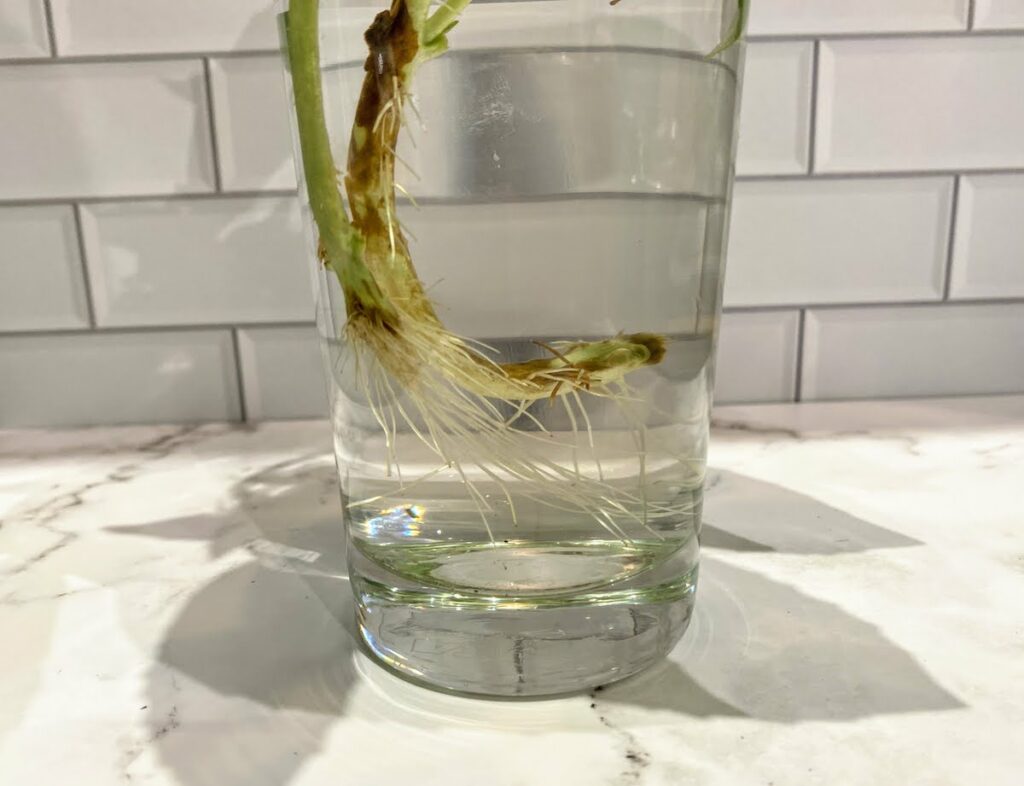
More Than 7,000 People Can’t Be Wrong!
For one-off problems with your basil or herb garden, a quick Google to solve the problem is great.
But if you want more help getting the herb garden of your dreams, mastering cooking with basil, or other creative uses of basil, Skillshare has some awesome herb-related courses (plus a ton of other interesting, useful and cool courses).
To date, more than 7,000 students have taken Indoor Gardening: Grow Houseplants, Veggies, and Herbs!
Normally Skillshare Gives A 7-Day Free Trial. You Get A 30-Day Free Trial (OR 30% Off An Annual Membership)
Our friends at Skillshare have graciously offered our readers an extended free trial, using this link here to sign up. Instead of 1 week to try out all their courses, you get a full month to try courses like:
- Indoor Gardening: Grow Houseplants, Veggies, and Herbs // (use this link to get a 30-day Free trial) // (use this link to 30% off an Annual Membership)
- Create a Small Space Edible Garden // (use this link to get a 30-day Free trial) // (use this link to 30% off an Annual Membership)
- 5 Easy to grow herbs, sowing, growing and harvesting // (use this link to get a 30-day Free trial) // (use this link to 30% off an Annual Membership)
- Crafting Infused Tea: Herb, Flower, and Fruit Iced Teas // (use this link to get a 30-day Free trial) // (use this link to 30% off an Annual Membership)
Sign up for a FREE 30-Day Trial (this link only)
Or Save 30% Off An Annual Skillshare Membership
If you know you’re going to love Skillshare, you can also sign up for an annual membership and save 30% with this link.
Propagating Basil is the Easy Path to a Ton of Basil
If you’re a basil fanatic, you might find it tough to grow enough basil to meet your kitchen needs.
Pesto alone takes a ton of fresh basil, never mind making fresh pesto, pizza, and other recipes, too.
If you find yourself constantly buying basil at the grocery store, and are looking a better solution, propagating basil from cuttings is a great option.
Plant propagation lets you root basil stem cuttings in water, and then transplant into good quality potting mix in your planters.
Best of all?
Propagating basil is easy, even for novice basil gardeners, and you can do it all indoors.
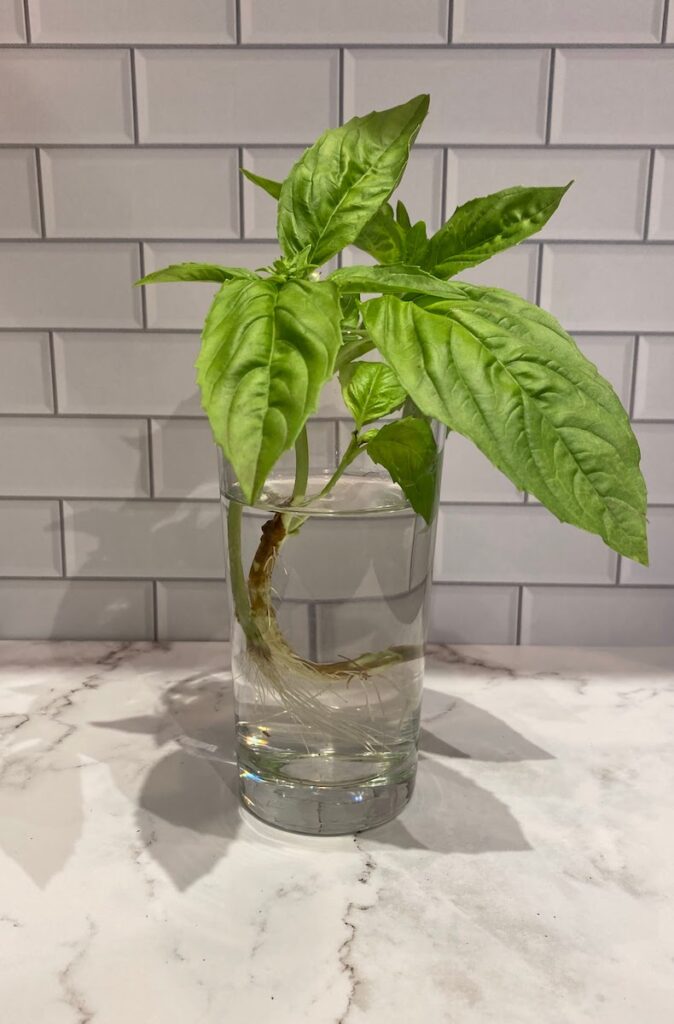
Step by Step Instructions for Growing Basil Plants from Cuttings
Start with a Healthy Basil Plant
It’s easy to propagate basil, especially if you have a healthy start.
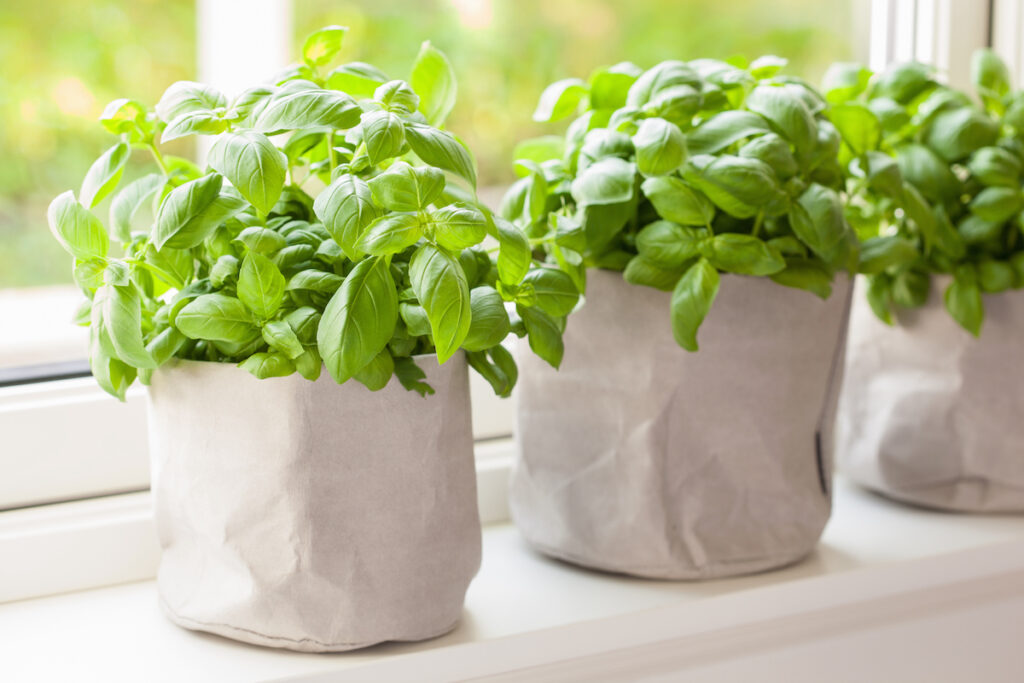
And to get a healthy basil cutting, you need to start with a healthy, mature basil plant, without any signs of distress or infestation, such as wilting or droopy leaves, white areas, brownish colored patches or spots, black spots, yellowing on certain leaves or the entire plant, or holes on the sides or even in the middle of the leaves.
We’ll call these healthy cuttings the mother basil plants.

When propagating basil plants, you can use a mother plant from basil in your garden, plant one from seed and wait until its ready to be a mother plant (more practical for hard to find types of basil), or buy an established plant from your local garden center or grocery store. In my experience, live herb plants are usually found in the produce section of the grocery store.
If you can’t find what you’re looking for, you could also try asking on your local Buy Nothing Group. I got a Large Leaf basil cutting from there, which I’m now happily propagating! I also got my Persian Basil seedling for free from Craigslist.
What’s fun about propagating is it can create a never ending cycle (almost). I got a free Persian basil seedling and planted it, then took a cutting and propagated it. Now instead of one productive plant, I have two! And they were both free!


Easier than planting from seed, but you can still collect the seeds yourself at the end of the growing season. Double win!
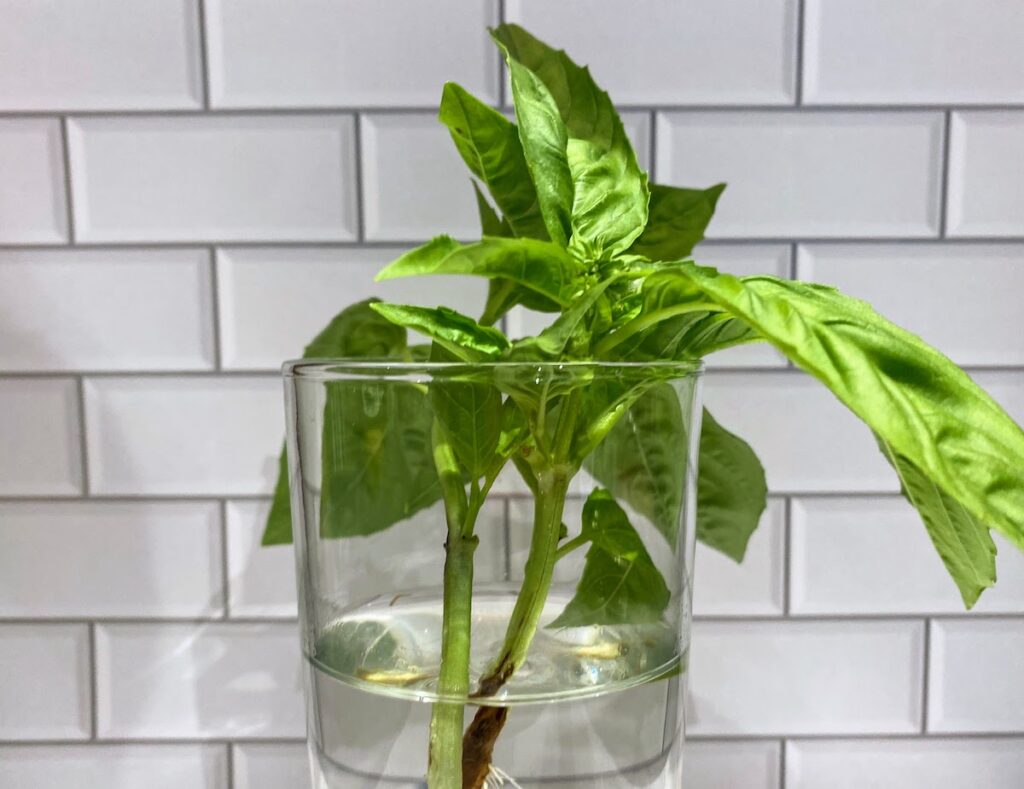
In addition to using healthy mother basil plants to get your basil cuttings from, they also need to be mature enough to warrant a prune, but not mature enough to be flowering. Wait to trim your cutting until the mother basil plant has 3 or 4 leaf nodes on it.
Prune Your Basil Plant
Once you have a healthy, mature basil plant to serve as the mother plant, it’s time to trim your cutting(s). You can cut one, or several cuttings, to root basil in water.
Cut the stem on an angle, just above the lowest leaf node. The cutting you take should be about 4″ to 6″ long.
Don’t feel badly about taking too much off the mother basil plant, as long as you take the cuttings from above the lowest leaf node. Regularly pruning your basil plants is essential for healthy, bushy plants that grow into a nice full bush. In fact, collecting a basil harvest regularly actually helps the plant to keep growing – it prevents them from getting too leggy and tall.
If you prune all the stems above the lowest leave node, and still want more cuttings, you’ll need multiple mother basil plants to start with. For one mother plant, you should be able to get about 8 to 12 cuttings.
Pinch and Trim
The stem(s) you trim off the mother basil plants are your cuttings. Before putting your basil cutting in water, you need to prepare the cuttings.
First, pinch off the lower sets of leaves on the cutting, leaving just the top leaves in place. Keeping the top leaves in place on the cuttings is essential to growing basil, as they’ll allow photosynthesis to continue.
Second, trim the bottom of the cutting stem, chopping about 1/4″ below the lower (leafless) leaf node.
I like to set aside any basil leaves I pinch off to use for an upcoming meal that same day.
Rooting Basil Cuttings in Water

Growing basil in water is best done in glass, so choose a glass of water or glass jar (mason jar, thoroughly cleaned old glass food jar, etc.) to propagate basil.
Fill the jar or glass about 2/3 full of un-chlorinated water. Depending on where you live, your tap water likely has some level of chlorine in it. De-chlorinate tap water in advance, by bringing it to a rolling boil, boiling for at least 20 minutes, and then cooling to room temperature. While you can try to grow basil plants in normal tap water, you’re likely to get better results by taking the time to de-chlorinate the water.
Place your basil cuttings in the jar or jars of water. You can place a few cuttings in each jar. However, as the root systems develop, you’ll need to make sure they don’t get tangled together. If they do intertwine, you’ll need to plant them together, too.
When rooting cuttings, the stems should sit in the water, fully submerged. However, the leaves should be above the water line, and can rest on the rim of the jar.
Change the Water Regularly
Every couple of days, change the water for the cuttings. Just as basil growing in your garden or in a pot needs regular fresh water, so do cuttings! Each time, go through the process of de-chlorinating the water by boiling and bringing it to room temperature, before changing.
Changing the water regularly will help prevent bacterial growth and keep your basil cuttings healthy.
If you don’t remember to change the water regularly, it can blow the whole project. I forgot to change the water on the basil cutting pictured below before we went on vacation. The leaves are wilted and have brown patches on them, and it generally looks sad. Thankfully the tap root still looks healthy so I’m hoping I can revive it. I did have to put its sister cutting in the compost unfortunately, as the stem had turned black and was rotting.
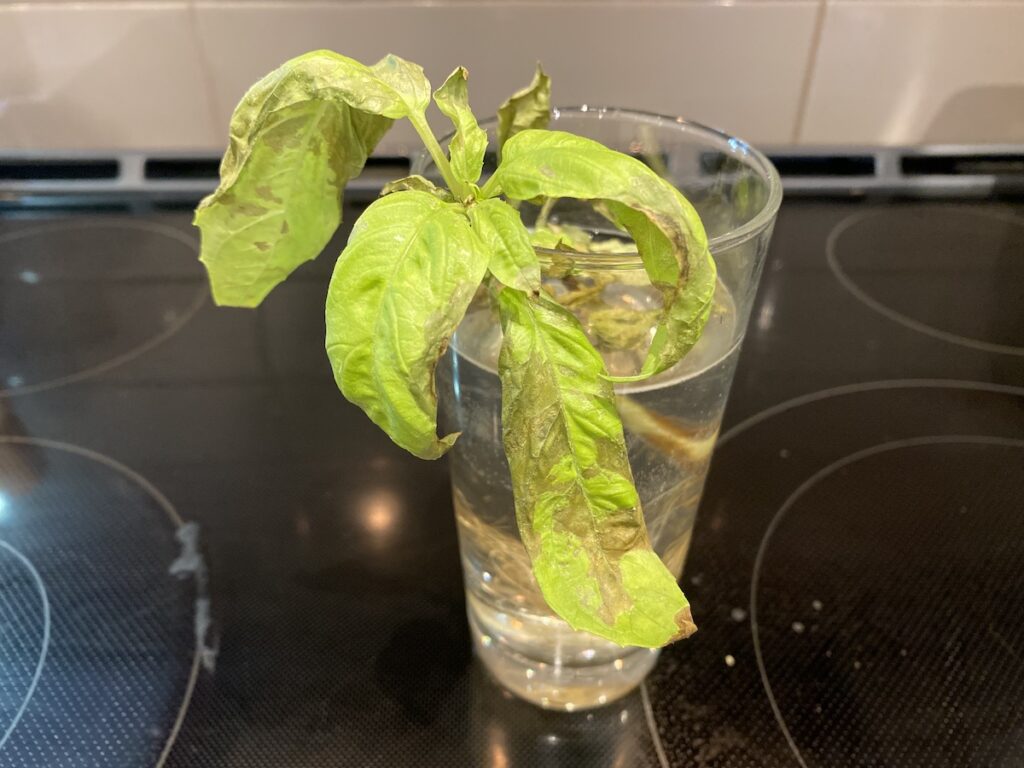
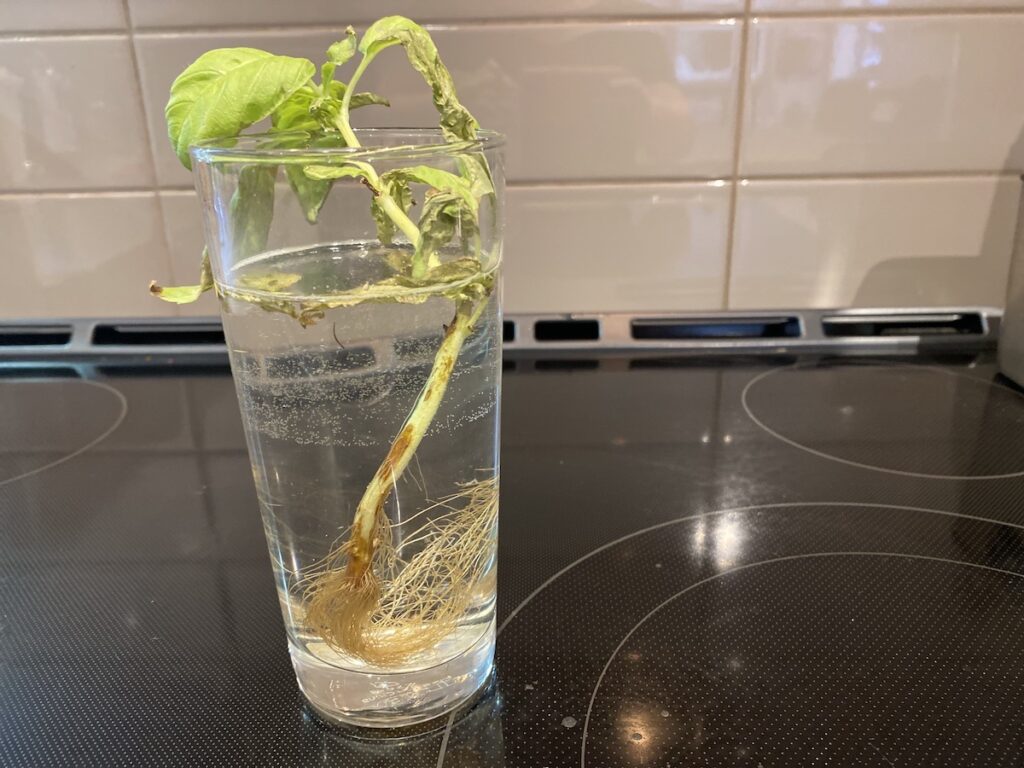
Sun & Wait
Place your jar somewhere indoors where it’ll get direct morning sunlight, and indirect afternoon sunlight. Basil loves sunlight, but you don’t want to expose these babies to direct, hot afternoons sun, as it it may be too much for them! A windowsill generally works great for this, but consider your own home’s set up and what might fit best.
After two weeks, you should notice roots developing out of the bottom of the basil cutting.
After about four weeks, it should have a fairly established set of roots that are at least 2 inches to 3 inches long.
Congratulations! At this point, you’ve grown yourself a new basil plant! The best part about this process is you can do it year round, – even in winter, when basil typically dies as a fairly fragile annual plant.
Transplanting into Potting Mix
At this stage, you can transplant your basil cuttings to some nicely sized pots or directly into your garden, planting indoors or out.
Planting in Pots, Indoors or Out
At this stage, I recommend transplanting your plants to a pot or planter box to continue growing, using high quality potting mix to keep them healthy.
To do so, fill a well-draining pot about 1/2 full with potting soil or potting mix, and place the cutting on the soil, teasing out the roots on the soil gently so as to not damage them (you can group several cuttings together in one pot).
Gently fill the pot with potting soil, covering the root system as you go without being too aggressive, until the cuttings can stand on their own.
Water the plants so the potting mix is damp, but not soaking, and stick to a regular watering schedule.
Place the pots somewhere sunny indoors for a few days, to give the plants time to adjust. If you want to move them outdoors, do so only once the plants are thriving in their new, non-aqueous home, and consider doing so gradually. Note that basil doesn’t do well with cool temperatures, so you won’t want to move your new basil plants outdoors until very late spring or early summer, once warmer temperatures have arrived to your region.
Planting Directly in Your Garden
You can also plant the new basil in your garden directly, although this is fraught with more risk. Only do so once the last frost of spring is well behind you, in early summer, and the soil has warmed up.
How to Propagate Basil from Cuttings – Summary and Tips for Rooting New Basil in Water
- If you plan to plant your new basil plants outdoors, you’ll need to time it right. Basil is best planted in late spring or early summer, after the last frost, so start 3 to 4 weeks before that! If you plan to plant them in an indoor herb garden, timing is less of a concern.
- I like to grow many basil cuttings at once. I find I can get about 8 to 12 cuttings from one grocery store basil plant / mother plant. Expect that some of the plants won’t make it, so one mother plant should give you 6 to 8 successful new basil plants, accounting for casualties.
- Consider sunlight and temperature when placing your cuttings somewhere to grow. Direct morning sun and indirect afternoon sun is ideal, which is why a windowsill is generally ideal. However, you may need to move your plants in the afternoon if the sun is too intense, or move them away from the window at night if the temperature drops too much, and it gets drafty and cold around the window. If the window glass gets quite hot or quite cold, you’ll also want to keep the leaves from touching the window!
- De-chlorinated water really works best, which you can achieve with the boiling method described above, or by simply leaving water out for a day or two, for the chlorine to evaporate. However, you’ll also want to use water that has reached room temperature so there isn’t a huge temperature difference when your change the water, swapping old for fresh water, every couple of days.
- Once it comes time to transplant the basil to soil, you’ll need to give them some extra love and care. Pay extra attention to ensure the soil stays nice and moist, and there’s lots of drainage.
Frequently Asked Questions
Will basil cuttings root in water?
Yes, basil cuttings will develop a robust root system over the course of several weeks, so long as they’re kept in dechlorinated water and provided with adequate sunlight. If you find your basil cutting wilting or otherwise not thriving, try moving it to a warmer location with more sunlight.
How do you start a basil plant from a cutting?
Choose a healthy, established mother plant and take a cutting by cutting the stem just above the lowest node of leaves. Remove the lowest leaves to leave about 1/4″ of bare stem, and place in a glass cup or jar of fresh, dechlorinated water, keeping the basil leaves above the waterline. Put the cup somewhere sunny, and change the water every few days. Over the course of a few weeks, the plant will develop roots, and you can transplant it into a pot.
Can I grow basil from cuttings in water?
Yes, you can grow basil in water, and there’s no need to transplant it into soil.
How do you keep basil alive in water?
Basil can continue to grow in water for a long time, as long as it has the right conditions and nutrients. Ensure your basil cutting gets 4 to 6 hours of direct sunlight per day and is in a relatively warm location. You’ll also need to add fertilizer once a month or so to meet its nitrogen needs in particular.
Can basil be propagated forever?
Basil is an annual plant that, left to its own devices, will grow, flower, go to seed and die at the end of each growing season. While you can keep basil alive for longer, one basil plant will not last forever. However, you can continue to take cuttings and propagate those cuttings from the same basil plant so long as the plant is healthy and thriving.
How do you transplant basil from water to soil?
Transplant basil from water to soil using the same method you would use to repot a basil plant or basil seedlings. Choose a pot with good drainage holes and fill it up a bit with some high quality potting soil mix. Add the basil cutting into the pot so all roots sit below the rim of the plant. And then top it up (gently) with more potting soil until the plant is securely planted.
